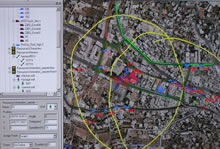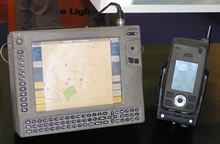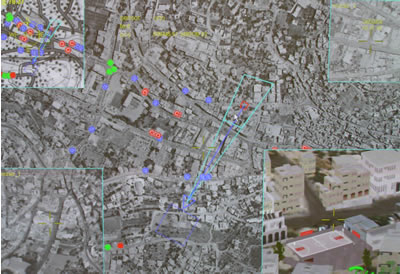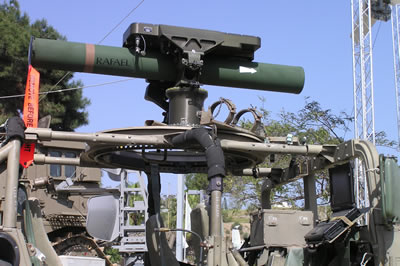The IDF is deploying several new systems that are designed to improve the integration between tactical forces, and their links to the regional and strategic command level. In 2002 the IDF launched an ambitious “Digitalized Land Forces” program which will “digitalize” its entire land force. Elbit Systems is the prime contractor for the Digital Army program. One of the key devices utilized for information distribution is the rugged Personal Digital Assistant, (RPDA-88) produced by Tadiran Communications. This device is a fully militarized Pocket-PC used by field commanders and troops. The system is provided with important functions such as situational awareness, communications and navigation derived from integral GPS, processing and networking services. Another system shown here was a new interconnection system, developed by Tadiran Communications, which provides connectivity between different networks, such as those of the Army, Air Force, police, emergency services and security forces. The system links to every network and utilizes a common Voice Over IP (VoIP) interface to provide clear communications between all networks. The company also unveiled its PRC-710MB, a lightweight multi-band, frequency hopping voice/data VHF/UHF hand held radio system.
 Elbit, in cooperation with Motorola Communications Systems is also fielding an integrated LIC C2 system, which will be deployed during 2004 with IDF units engaged in LIC activities. The new communication system tracks the location and status of deployed unit, assists in the creation of a unified situational picture and enables seamless transfer of messages, maps and images between deployed forces and command posts. The IDF has invested a great effort in a geographical survey of its theaters of operation, especially the urban area in the West bank and Gaza. The modeling of the area was done by Tiltan Systems Engineering which utilized a special graphical 3D engine which generates photo-realistic models of urban area. Using this 3D model, the IDF can plan, rehearse and simulate missions, on a “digital sand table” which realistically simulates the real scene. The 3D model also assist in fine tuning of operational plans, identifying potential problems such as observation, coverage, and potential engagements between friendly forces operating in the dense urban area. Elbit’s contribution to the IDF LIC operations also includes various observation systems, including the Long Range Observation Systems (LOROS), and the airborne Advanced Multi-sensor Payload System (AMPS), deployed on light aircraft, flying support missions for MOUT operations. The company also produces the Hermes 450 UAVs providing the core of the IDF UAV force. Integrated C4I systems also developed by Elbit facilitate seamless integration of forces, including ground – air and air-air voice and data connectivity between helicopters and ground forces, and effective control of snipers, as part of the MOUT operation. Another network, designed specifically for LIC and urban warfare is the Sniper Control System, which provides full control of multiple snipers, as part of a MOUT operation. Elbit developed several types of elevated sensors designed specifically for LIC. Lightweight, stabilized payloads can be mounted foldable masts or tethered under an aerostat. Other platforms provide accurate targeting for precision guided weapons, such as laser guided missiles and aerial munitions, the company also offers a portable lightweight laser designator (PLLD), which can be employed by forward troops and Special Forces or mounted on lightweight payloads. Ness TSG also introduced an integrated Tactical C2system designed to support tactical commanders in planning and decision making process.
Elbit, in cooperation with Motorola Communications Systems is also fielding an integrated LIC C2 system, which will be deployed during 2004 with IDF units engaged in LIC activities. The new communication system tracks the location and status of deployed unit, assists in the creation of a unified situational picture and enables seamless transfer of messages, maps and images between deployed forces and command posts. The IDF has invested a great effort in a geographical survey of its theaters of operation, especially the urban area in the West bank and Gaza. The modeling of the area was done by Tiltan Systems Engineering which utilized a special graphical 3D engine which generates photo-realistic models of urban area. Using this 3D model, the IDF can plan, rehearse and simulate missions, on a “digital sand table” which realistically simulates the real scene. The 3D model also assist in fine tuning of operational plans, identifying potential problems such as observation, coverage, and potential engagements between friendly forces operating in the dense urban area. Elbit’s contribution to the IDF LIC operations also includes various observation systems, including the Long Range Observation Systems (LOROS), and the airborne Advanced Multi-sensor Payload System (AMPS), deployed on light aircraft, flying support missions for MOUT operations. The company also produces the Hermes 450 UAVs providing the core of the IDF UAV force. Integrated C4I systems also developed by Elbit facilitate seamless integration of forces, including ground – air and air-air voice and data connectivity between helicopters and ground forces, and effective control of snipers, as part of the MOUT operation. Another network, designed specifically for LIC and urban warfare is the Sniper Control System, which provides full control of multiple snipers, as part of a MOUT operation. Elbit developed several types of elevated sensors designed specifically for LIC. Lightweight, stabilized payloads can be mounted foldable masts or tethered under an aerostat. Other platforms provide accurate targeting for precision guided weapons, such as laser guided missiles and aerial munitions, the company also offers a portable lightweight laser designator (PLLD), which can be employed by forward troops and Special Forces or mounted on lightweight payloads. Ness TSG also introduced an integrated Tactical C2system designed to support tactical commanders in planning and decision making process.
Integrated C4I systems also developed by Elbit facilitate seamless integration of forces, including ground – air and air-air voice and data connectivity between helicopters and ground forces, and effective control of snipers, as part of the MOUT operation. Another network, designed specifically for LIC and urban warfare is the Sniper Control System, which provides full control of multiple snipers, as part of a MOUT operation. Elbit developed several types of elevated sensors designed specifically for LIC. Lightweight, stabilized payloads can be mounted foldable masts or tethered under an aerostat. Other platforms provide accurate targeting for precision guided weapons, such as laser guided missiles and aerial munitions, the company also offers a portable lightweight laser designator (PLLD), which can be employed by forward troops and Special Forces or mounted on lightweight payloads. Ness TSG also introduced an integrated Tactical C2system designed to support tactical commanders in planning and decision making process.
RAFAEL unveiled new technologies and systems, which can operate as stand alone systems, or integrate and improve wider C4I systems. The company is also introducing its C4ISR (RTC) system, to provide tactical units with independent support for mission planning, navigation, situational awareness, target acquisition and engagement. The system functions with ruggedized laptop computers and can be employed with mobile and dismounted troops, including Special Forces. This application, formerly known as Spike C4I, was tested with units equipped with the Spike missile where it demonstrated improved combat effectiveness of small units by accelerating the sensor-to-shooter cycle between reconnaissance and assault forces. Other technologies include a new data fusion platform, designed to integrate multiple data feeds from many sensors can generating cohesive, dynamic situational picture in real time, where multiple instances of a single target (such as vehicle moving along a road) are depicted as a single, dynamic target. Data fusion algorithms are based on parameters such as geographic data and time stamps, as well as specific characteristics of every data source (such as sensors). The dynamic presentation helps simplifying a complex situation, by focusing the user’s attention to the relevant information, in a context based situational picture.





















